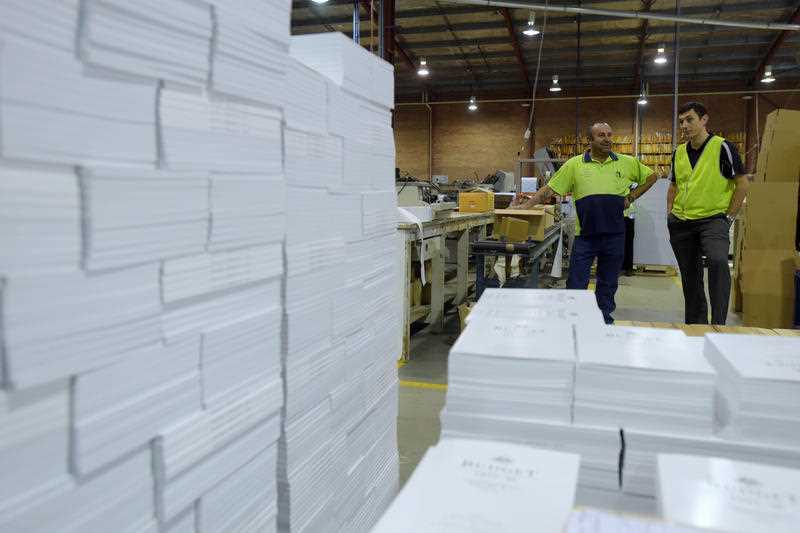White paper has become the latest in a long line of everyday products no longer made in Australia.
Its death knell – the final production run last month after 85 years of operations at the historic Opal mill in Victoria’s Latrobe Valley – raises questions about the survival of towns built on the back of old-school industry.
About 200 workers lost their jobs when the decision was made on Valentine’s Day to permanently shut down the machines that had churned out stationary and office supplies for more than 80 years at the Maryvale Mill.
It won’t be the last traditional Australian industry to be replaced.
Like the crews who assembled Holden cars before them and miners who extract coal across the nation who expected jobs for life, the workers are left to reinvent themselves.
The loss of jobs at Opal, because of a lack of timber, is the most recent in a long line of blows for the Latrobe Valley.
The end of the Hazelwood power station in 2017 led to the retrenchment of about 1000 workers, two other coal-fired power plants are set to close over the next 12 years and the future of other legacy enterprises is in doubt.
Jobs expert and local resident Jennifer McCafferty says the situation is “scary”.
“What is the next opportunity for those sorts of dollars? We’re talking fly in, fly out work and that’s not good for families,” she says.
Ms McCafferty leads Gippsland Employment Skills Training, which provides training and support to workers such as those losing their livelihoods at the paper mill.
She believes many are eyeing positions in renewable energy set to be created through the Andrews government’s revival of the State Electricity Commission, which will help Victoria move to being almost entirely green-powered within decades.
Unions say they are supporting them and the government is working with Opal to minimise redundancies.
The local council is pushing for the renewable job opportunities to be fast-tracked but workers need to look for employment elsewhere in the meantime.
Ms McCafferty says many former Hazelwood employees had transferable skills but that only went so far.
“Somebody from outside the area will say, ‘why don’t they all go work in aged care because that’s a skill shortage?’ That’s not going to work,” she says.
Latrobe City Business Chamber president Peter Ceeney is bracing for a “butterfly effect” across the Valley.
While the Maryvale mill will continue to make brown paper, he fears transport, safety, maintenance, contractors and catering workers will be impacted by the end of white paper production.
“The question is: can manufacturing and heavy industry jobs be transferred into health and other industries?” Mr Ceeney said.
“Is that transition possible, or are we just going to have a whole heap of people that are going to retire early? I don’t think that transition is as easy as it’s made out to be.”
Workers who stay in the area face three possible outcomes, according to Melbourne University Professor Irma Mooi-Reci.
They will either find a new job, rely on welfare or wait for other government support.
She said all could have impacts on their mental health and there was a risk some workers could be underemployed or forgotten.
“It is not a remote event that is only happening in Victoria; this extends beyond Victoria and it has a huge impact for the Australian economy,” Prof Mooi-Reci said.
A report from the Latrobe Valley Authority shows the area tends to have a higher unemployment rate than the rest of Victoria and has a lower workforce participation.
La Trobe University associate professor Buly Cardak points out there could also be a knock-on effect to the local housing market if lost workers decide to pick up and leave, while others may not be able to if they find the cost of housing too high in bigger markets.
“At least unemployment is low so there’s demand for workers if they can get the training … they should get good opportunities but it comes at a price of having to relocate and uproot your family,” Dr Cardak says.
Monash University professor Gennadi Kazakevitch believes the end of white paper production in Australia is symbolic of issues impacting the broader economy, particularly a reliance on international supply chains and cheap imports.
The former deputy head of the university’s economics department lived in the Latrobe Valley during the 1990s when thousands lost their jobs during an energy restructure.
Although many workers found new roles, Dr Kazakevitch says the country is now in a very different place.
“We are facing a trend, eliminating one industry after another,” he says.
Australia prospered from the wool, agriculture, engineering, automotive and resource sectors for more than a century.
Dr Kazakevitch says while law, the financial industry and services will stay strong, there isn’t a clear picture of what industry will be the next backbone of the Australian economy when the mining boom ends.
That should concern all Australians, he says.
“We’re not preparing the economy, the country, the labour force, the population for what is coming next.”
By Rachael Ward in Melbourne



